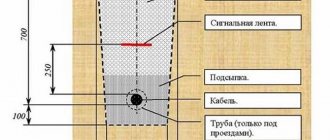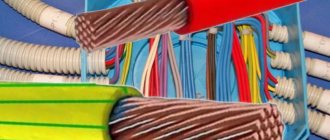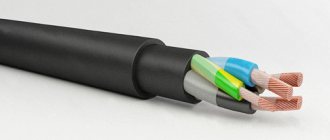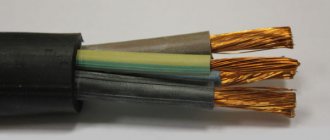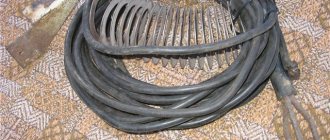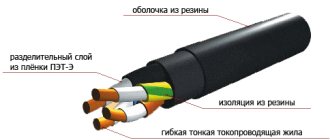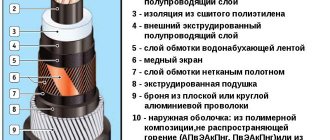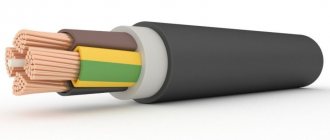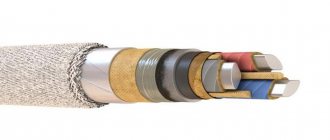The cable type VBBShV is intended for connecting stationary (fixed) electrical installations of alternating or direct current with voltage up to 6000 V, if it is necessary to carry out installation in conditions where it is impossible to enclose the cable in a reliable protective sheath, while it is necessary to guarantee the integrity and durability of the route. This type of electrical products has a complex composite structure that includes armor protection. There are such varieties as cable VBBbShvng, that is, non-flammable, control cable type KVBbShv, and others.
How does VBBShv stand for?
Marking VBBShv means:
- “B” - internal insulation is made of PVC materials;
- “BB” - the armor is made of metal strips;
- “Shv” - the outer layer is made of PVC material.
What the product looks like
There are also subtypes with the symbols “-ng”, which indicates that the cable does not spread fire, and “ng-ls” indicates that the product emits little smoke.
Note! If the marking does not contain the symbol A, then the conductors are made of copper.
Explanation of VBShv marking:
Like any other abbreviation, VBShv has its own meaning.
B – the presence of an insulating coating made of special polyvinyl chloride plastic.
B – the presence of an armored coating, which is provided by means of special galvanized steel strips.
Seam – the presence of a special plastic coating.
The cost of VBBShv is directly dependent on the price of the materials from which the product was made. Prices for products are indicated in the price list posted on the company's website. We provide a flexible discount system. Detailed information regarding the final cost of a cable of this brand should be clarified with a company employee.
You can buy special products in two ways - for cash and by transferring from account to account. The assortment that is in stock is shipped within one business day after funds are credited. Delivery times for custom-made models should be confirmed with our employees.
Technical specifications
Below are the main parameters of the product:
- permissible temperature range from −50 to +70 degrees;
- voltage during operation 0.77-3 kV;
- air humidity should not exceed 95%;
- the laying process must be carried out at a temperature not lower than −13;
- the permissible bend radius when laying single VBBSHV is 12 outer diameters, and for multi-core 6 outer diameters;
- minimum frequency 45 Hz.
VBBShV cable length characteristics
Even more parameters can be found in the product specifications.
During operation, the maximum air temperature will be 85 degrees. If the temperature is above 100 degrees, then the cable operation must stop from time to time. Since elevated temperatures can cause short circuits or failure of all devices. The cable service life is 25-30 years. The warranty can be a maximum of 5 years, under proper storage conditions.
The best manufacturers
A wide range of VBBShv makes it possible to choose a product of the required color. A quality certificate guarantees the purchase of a cable from a reliable manufacturer, however, not all products comply with state standards. The best manufacturers of VBBShv include:
- Kavkazcable;
- Kamkabel;
- Kolchuginsky plant;
- Pskovkabel;
- Sevkabel;
- Uralcable;
- Energy cable.
These manufacturing plants guarantee high quality products for many years. Professionals recommend purchasing products from these manufacturers, because... They themselves trust them, as evidenced by numerous reviews.
Cable design
The design of the VBBShV cable consists of:
- conductive wires, which are made from copper or aluminum. They can be oval or round in shape. Also, the cores can be either whole or with a large number of small wires. With this, the flexibility of the product increases, and Foucault currents (which cause overheating of the wire) are reduced;
Cable design
- Oval-shaped cores are used in multi-core products. Thanks to this shape, it is possible to expediently fill the internal space of the wire and, with the same outer diameters, obtain a larger cross-sectional area. But this shape adds a lot of weight to the cable;
- the product is insulated using PVC materials, which protect the cores from electrical contact with each other and with the external environment. Each core can have its own insulation color to avoid confusion;
- the armor is made of metal tape wrapped in two layers;
- The outer layer is made of thick PVC raw material hose. It protects the product from mechanical damage or precipitation.
You might be interested in this: Electrics in a log house
The process of laying underground
PvBBShv or polyethylene versus PVC
The PvBBShV cable, in which the basic core insulation is made of vulcanized polyethylene material, deserves special attention in this list. Like other predecessors, it can be single- or multi-core (from 2 to 4). The cross-section of an individual PvBbShV core can vary in the range from 4 to 240 mm2. The weight of a linear meter of cable varies from 0.44 to 8.69 kg for sizes 2x6 and 4x240. In this case, the maximum outer diameter is 54.2 mm.
PvBBShV can be used in rather difficult climatic conditions, in rooms with different levels of corrosive activity of the environment, and the possibility of mechanical damage. This automatically means that the manufacturer of PvBbShV provides the possibility of laying it in the ground, in specially equipped trenches.
Temperature operating conditions of PvBBShV at rated, emergency and critical (SC) currents are also not much different from previous modifications.
Power cables of the type PvBbShV or VBBShVng can be used within a fairly wide climatic and physical-technical framework, which makes them practically irreplaceable and quite universal products.
Scope of use
Basically, the product is intended for the transmission and distribution of electrical energy to objects located at different distances, in a situation where the use of bare or unprotected wires is impossible due to the high risk of fire or the likelihood of external mechanical damage.
Armored cables can be used in the following areas:
- underground installation in the soil;
- for power generation devices in tunnels or mountainous areas;
- laying above ground or in trenches;
- installation in cable ducts, corridors or on cable bridges;
- installation of electrical networks in residential premises.
VBBShng, VBBShvng
View prices →
Description
VBBShng and VBBShvng cables are power cables with copper conductors, armored, in PVC insulation with a protective cover of the Shng type (ng - flame retardant), designed for the transmission and distribution of electrical energy in stationary installations at a rated alternating voltage of 1.0 kV, frequency 100 Hz or DC voltage is 2.5 times higher than alternating voltage. Cables do not propagate combustion when laid in bundles.
VBBShng and VBBShvng cable design:
- Copper current-carrying conductor: - single-wire (class 1) with a cross-section of 2.5-50 sq. mm - “ozh”, - multi-wire (class 2) with a cross-section of 50-625 sq. mm;
- PVC insulation, - color marking of conductors: white or yellow, blue or green, red or crimson, brown or black, - digital marking of conductors for cables with a cross-section of 70 sq. mm and above: 1, 2, 3, 4, 0;
- Belt insulation made of PVC tapes;
- Armor made of galvanized steel strips;
- Hose made of PVC plastic compound of low flammability.
Explanation of cable VBBShng and VBBShvng:
C - Insulation of cores made of polyvinyl chloride plastic B - Armor made of two steel tapes b - Without a cushion, which is the inner part of the protective cover, applied under the armor in order to protect the element underneath from corrosion and mechanical damage by armor tapes or wires Shng - Protective cover c in the form of a pressed hose made of polyvinyl chloride plastic compound of reduced flammability
Characteristics
Conditions for laying and operating cables VBBShng and VBBShvng:
The cables are manufactured for use in areas with temperate and cold climates. The cables are designed for use on land, rivers and lakes at altitudes up to 4300 m above sea level, in the absence of tensile forces during operation. — in inclined and horizontal routes; - on open air; — in rooms (volumes) with high humidity; — in subway structures; - in pipes and in the ground (trenches) in certain sections of the cable route, subject to additional protection from mechanical damage; — in fire hazardous areas; — in explosive zones of class BI, B-Ia, B-Ib, B-Ig, B-II, B-IIa.
| Humidity at 35°C | 98% |
| Warranty period [month] | 60 months |
| Test alternating voltage with a frequency of 50 Hz, 10 min. | 3.5 kV |
| Maximum operating temperature of the core | 70°C |
| Maximum AC voltage frequency 50 Hz | 1.2 kV |
| Installation at a temperature not lower | -15°C |
| Rated alternating voltage frequency 50 Hz | 1.0 kV |
| Bending radius of multi-core cables, not less | 7.5 bed diameters |
| Bending radius of single-core cables, not less | 15 bunk diameters |
| Insulation resistance at temperature +70° C, not less | 0.005 MOhm x km |
| Ambient temperature, upper limit | +50°C |
| Ambient temperature, lower limit | -50°C |
| Temperature of conductors during a short circuit | 160°C |
| The permissible heating of current-carrying conductors in emergency mode should not exceed | +80°С |
Group characteristics
Power cables with plastic insulation for low voltage
This group includes cables with aluminum or copper conductors with plastic insulation in a plastic sheath, with or without protective covers, intended for the transmission and distribution of electricity in stationary installations at a rated alternating voltage of 0.66 - 6 kV with a frequency of 50 Hz at ambient temperature from -50°С to +50°С.
Brands, design elements and applications
| Cable brand | Core material A - aluminum M - copper | Insulation P - polyethylene B -PVC plastic | Shell P - polyethylene B -PVC plastic compound Vng - PVC plastic compound of reduced flammability | Protective cover (section 4.1) |
| APVG | A | P | IN | absent |
| AVVG | A | IN | IN | absent |
| VVG | M | IN | IN | absent |
| AVVGng | A | IN | Vng | absent |
| VVGng | M | IN | Vng | absent |
| AVVGz | A | B (with filling) | IN | absent |
| VVGz | M | B (with filling) | V | absent |
| AVBbShv | A | IN | absent | BbShv |
| VBBShv | M | IN | absent | BbShv |
| AVBbShng | A | IN | absent | BbShng |
| VBBShng | M | V | absent | BbShng |
| AVVB | A | V | IN | B |
| VVB | M | V | IN | B |
| AVVBG | A | V | IN | BG |
| VVBG | M | V | V | BG |
The basic brands in this group of cables are APVG, AVVG, VVG, AVVGz, VVGz, AVBbShv, VBBShv. Cables are produced in accordance with GOST 16442-80.
APVG, AVVG, VVG cables are intended for installation in dry and wet industrial premises, on special cable racks, and in blocks. At the same time, cables of the AVVGz and VVGz brands are used for power supply to electrical installations that require cable sealing during entry, and they are recommended for laying in the ground with low corrosive activity and the absence of the possibility of mechanical damage and tensile forces.
Cables of the AVBbShv and VBBShV brands are intended for all of the above applications (except for laying in blocks), but if there is a risk of mechanical damage during operation.
To the designation of cable brands AVVG, VVG, AVBbShv VBBShV in tropical design, add the letter “T” through a hyphen, for cables with single-wire conductors - the letter “ozh” in brackets, for cables in flat design - through a hyphen, the letter “P”
Cables of the AVVGng, VVGng, AVBbShng and VBBShng brands differ from the basic brands in that the sheath or hose is made of low-flammability PVC plastic and are used to ensure the fire safety of cable chains when laid in bundles.
Cables of brands AVVB, VVB, AVVBG, VVBG differ from cables of brands AVVG and VVG in the presence of protective covers of type B and BG and are intended mainly for the same areas of application as cables of brands AVBbShv and VBbShv.
Design parameters
The number of cores in the cables, the range of nominal cross-sections of the cores and rated voltages are indicated in the table.
| Cable brand | Number of cores | Nominal core cross-section, mm2 | |||
| Rated cable voltage, kV | |||||
| 0,66 | 1 | 3 | 6 | ||
| VVG | 1,2,3 and 4 | 1,5-50 | 1,5-240 | — | — |
| VVGz | 2,3 and 4 | 1,5-50 | 1,5-50 | — | — |
| AVVG, APVG | 1,2,3 and 4 | 2,5-50 | 2,5-240 | — | — |
| AVVGz | 2,3 and 4 | 2,5-50 | 2,5-50 | — | — |
| AVBbShv, VBBbShv | 2,3 and 4 | 4-50 | 6-240 | 6-240 | — |
| AVVG, VVG, AVBbShv, VBBShv | 3 | — | — | — | 35-240 |
| AVVG, APVG | 5&6 | 2,5-50 | 2,5-35 | — | — |
| VVG | 5&6 | 1,5-25 | 1,5-25 | — | — |
For four-core cables, the largest nominal cross-section of the cores is 185 mm2.
Cables for voltages of 3 and 6 kV are made only with three cores. Two-core cables must have cores of the same cross-section. Three-, four- and five-core cables must have all conductors of the same cross-section or one conductor of a smaller cross-section (grounding or neutral conductor). Six-core cables must have four cores of equal cross-section and two wires of smaller cross-section.
The nominal cross-sections of neutral conductors (smaller cross-section) and grounding conductors must correspond to those indicated in the table.
Nominal sections of cores, mm2
| Basic | 1,5 | 2,5 | 4 | 6 | 10 | 16 | 25 | 35 | 50 | 70 | 95 | 120 | 150 | 185 | 240 |
| Zero | 1,5 | 1,5 | 2,5 | 4 | 6 | 10 | 16 | 16 | 25 | 35 | 50 | 70 | 70 | 95 | 120 |
| Grounding | 1,0 | 1,5 | 2,5 | 2,5 | 4 | 6 | 10 | 16 | 16 | 25 | 35 | 35 | 50 | 50 | 70 |
Current-carrying conductors can be single-wire or multi-wire in accordance with the table and must comply with classes 1 and 2.
| Core name | Nominal core cross-section, mm2 | |||
| round | shaped | |||
| copper | aluminum | copper | aluminum | |
| Solid wires | 1,0-50 | 2,5-240 | 25-50 | 25-240 |
| Stranded cores | 16-240 | 25-240 | 25-240 | 25-240 |
The current-carrying conductors of single-core cables of all cross-sections and multi-core cables with a cross-section of up to 16 mm2 must be round in shape. Conducting conductors of belt-insulated cables with a cross-section of 25 mm2 or more must be sector or segment shaped.
The radius of curvature of single-wire sector cores must be at least 0.5 mm.
It is allowed to manufacture cables with round conductors with a cross-section of up to 50 mm2.
The conductors are insulated, depending on the brand, with PVC plastic or polyethylene. The current standard provides for insulation made of cross-linked polyethylene (designation Pv).
The insulated cores of multi-core cables must have a distinctive color. The insulation of the neutral conductors should be blue (light blue).
The insulation of the grounding conductors must be two-color (green-yellow), with one color covering at least 30 and no more than 70% of the insulation surface, and the other the rest.
The color marking must be continuous or in the form of a longitudinal stripe with a width of at least 1 mm.
It is allowed to mark cores insulated with polyvinyl chloride plastic with numbers, starting from zero. Marking with numbers is done by embossing or printing. The height of the numbers is at least 4.0 mm. The distance between numbers should not be more than 35 mm.
The insulation of single-core cables can be of any color.
Cable insulation thickness, mm
| Rated voltage, kV | Nominal core cross-section, mm2 | Insulation made of polyethylene or polyvinyl chloride plastic | XLPE insulation |
| 0,66 | 1-2,5 | 0,6 | 0,7 |
| 4 and 6 | 0,7 | 0,7 | |
| 10 and 16 | 0,9 | 0,7 | |
| 25n35 | 1,1 | 0,9 | |
| 50 | 1,3 | 1,0 | |
| 1 | 1-2,5 | 0,8 | 0,7 |
| 4-16 | 1,0 | 0,7 | |
| 25 and 35 | 1,2 | 0,9 | |
| 50 | 1,4 | 1,0 | |
| 70 | 1,4 | 1,1 | |
| 95 | 1,5 | 1,1 | |
| 120 | 1,5 | 1,2 | |
| 150 | 1,6 | 1,4 | |
| 185 | 1,7 | 1,6 | |
| 240 | 1,9 | 1,7 | |
| 3 | 6-240 | 2,2 | 2,0 |
| 6 | 10-240 | 3.0 - for polyethylene | 3,0 |
| 3.4 - for polyvinyl chloride plastic compound |
Twisted insulated conductors must have gaps between them filled.
In cables of the AVVGz and VVGz brands, the PVC filling is applied simultaneously with the sheath and must be separated from the insulation and sheath without damage.
Cables with sector conductors, cables of the AVVG, APVG, VVG brands for voltages up to 1 kV inclusive, as well as cables of the AVBbShv and VBbShv brands with conductors with a cross-section of up to 25 mm2 inclusive can be without filling.
In cables of the AVVG, VVG, APVG brands for voltages up to 1 kV inclusive, a tape made of polyethylene terephthalate film or polyvinyl chloride plastic compound or other equivalent material and a sheath made of pressed-out polyvinyl chloride plastic compound must be overlapped over the twisted insulated conductors.
It is allowed to manufacture cables without tapes over twisted insulated cores, provided that the mobility of the insulated cores is maintained and the sheath can be separated from the insulation without damaging it.
In cables of all brands, except those indicated and brands AVVGz, VVGz, belt insulation must be applied over the twisted insulated cores.
The belt insulation must be pressed out of the insulation material or from polyvinyl chloride plastic compound or applied by winding or longitudinally with strips of polyethylene terephthalate film, polyvinyl chloride plastic compound or other equivalent material.
For cables with voltages up to 3 kV inclusive, belt insulation consisting of two strips of polyethylene terephthalate film and two strips of crepe paper is allowed.
The nominal thicknesses of PVC shells must correspond to category Obp-2
Reference values of outer diameters and weights of cables of individual standard sizes are indicated in the tables
Taking into account significant tolerances, actual values may differ by 5-10% down or up.
On the plastic sheath or protective hose, no more than every 300 mm, the distinctive index of the manufacturer and the year of manufacture of the cable must be applied.
Electrical Requirements
The cables must withstand an alternating voltage test with a frequency of 50 Hz for 10 minutes. The test voltage values are given in the table.
| Rated cable voltage, kV | Test voltage value |
| 0,66 | 3 |
| 1 | 3,5 |
| 3 | 9,5 |
| 6 | 15 |
Electrical insulation resistance of cables, MOhm
| Core cross-section, mm2 | Electrical resistance, MOhm |
| With PVC insulation for voltage 0.66 and 1 kV | |
| 1 and 1.5 | 12 |
| 2,5-4 | 10 |
| 6 | 9 |
| 10-240 | 7 |
| With PVC insulation for voltage 3 kV | |
| 1 — 240 | 12 |
| With PVC insulation for voltage 6 kV | |
| 1 — 240 | 50 |
| With polyethylene insulation | |
| 1 — 240 | 150 |
Outer diameters of cables for voltage 0.66 kV, mm
| Nominal core cross-section, mm2, nx S | AVVG, VVG | AVBbShv, VBBbShv |
| 1x1.5 | 5,0 | — |
| 1x2.5 | 5,5 | — |
| 1x4 | 6,1 | — |
| 1x6 | 6,6 | — |
| 1x10 | 7,8 | — |
| 1x16 | 9,3 | — |
| 1x25 | 11 | — |
| 1x35 | 12 | — |
| 1x50 | 14 | — |
| 2x1.5 | 7,6 | — |
| 2x2.5 | 9,1 | — |
| 2x4 | 10,5 | 15 |
| 2x6 | 11,5 | 16 |
| 2x10 | 14 | 19 |
| 2x16 | 16 | 20 |
| 2x25 | 19 | 24 |
| 2x35 | 21 | 26 |
| 2x50 | 25 | 29 |
| 3x1.5 | 8,0 | — |
| 3x2.5 | 9,5 | — |
| 3x4 | 11 | — |
| 3x6 | 12 | 16 |
| 3x10 | 14,5 | 17 |
| 3x16 | 17 | 19 |
| 3x25 | 20,5 | 21 |
| 3x35 | 23 | 25 |
| 3x50 | 27 | 31 |
Weights of cables for voltage 0.66 kV, kg/km
| Nominal cross-section of cores, mm2 | AVVG | VVG | AVBbShv | VBBShv |
| 1x1.5 | — | 37 | — | — |
| 1x2.5 | 35 | 51 | — | — |
| 1x4 | 45 | 70 | — | — |
| 1x6 | 55 | 91 | — | — |
| 1x10 | 80 | 140 | — | — |
| 1x16 | 115 | 215 | — | — |
| 1x25 | 160 | 320 | — | — |
| 1x35 | 200 | 420 | — | — |
| 1x50 | 260 | 570 | — | — |
| 2x1.5 | — | 67 | — | — |
| 2x2.5 | 75 | 105 | — | — |
| 2x4 | 97 | 140 | 320 | 370 |
| 2x6 | 120 | 190 | 360 | 440 |
| 2x10 | 170 | 290 | 460 | 590 |
| 2x16 | 220 | 410 | 550 | 750 |
| 2x25 | 330 | 630 | 700 | 1050 |
| 2x35 | 400 | 820 | 810 | 1300 |
| 2x50 | 560 | 1200 | 1050 | 1700 |
| 3x1.5 | — | 90 | — | — |
| 3x2.5 | 90 | 140 | — | — |
| 3x4 | 120 | 200 | 360 | 440 |
| 3x6 | 150 | 260 | 400 | 520 |
| 3x10 | 220 | 410 | 520 | 710 |
| 3x16 | 290 | 600 | 630 | 940 |
| 3x25 | 440 | 810 | 830 | 1300 |
| 3x35 | 550 | 1300 | 1000 | 1700 |
| 3x50 | 760 | 1700 | 1300 | 2200 |
Outer diameters of cables for voltage 1 kV, mm
| Nominal cross-section of cores, mm2 | AVVG, VVG | AVBbShv, VBBbShv |
| 1x1.5 | 5,4 | — |
| 1x2.5 | 5,8 | — |
| 1x4 | 6,7 | — |
| 1x6 | 7,2 | — |
| 1x10 | 8 | — |
| 1x16 | 9,5 | — |
| 1x25 | 11 | — |
| 1x35 | 12 | — |
| 1x50 | 14 | — |
| 1x70 | 17 | — |
| 1x95 | 19 | — |
| 1x120 | 21 | — |
| 1x150 | 23 | — |
| 1x185 | 25 | — |
| 1x240 | 28 | — |
| 2x1.5 | 8,4 | — |
| 2x2.5 | 10 | — |
| 2x4 | 11,5 | — |
| 2x6 | 12,5 | 17 |
| 2x10 | 14 | 19 |
| 2x16 | 16 | 21 |
| 2x25 | 20 | 24 |
| 2x35 | 22 | 26 |
| 2x50 | 25 | 30 |
| 3x1.5 | 9,4 | — |
| 3x2.5 | 10,5 | — |
| 3x4 | 12 | — |
| 3x6 | 13 | 18 |
| 3x10 | 15 | 20 |
| 3x16 | 17 | 22 |
| 3x25 | 21 | 25 |
| 3x35 | 23 | 28 |
| 3x50 | 27 | 31 |
| 3x70 | 29 | 33 |
| 3x95 | 32 | 37 |
| 3x120 | 36 | 40 |
| 3x150 | 39 | 44 |
| 3x185 | 43 | 47 |
| 3x240 | 49 | 53 |
Weights of cables for voltage 1 kV, kg/km
| Nominal cross-section of cores, mm2 | AVVG | VVG | AVBbShv | VBBShv |
| 1x1.5 | — | 42 | — | — |
| 1x2.5 | 39 | 55 | — | — |
| 1x4 | 55 | 80 | — | — |
| 1x6 | 60 | 100 | — | — |
| 1x10 | 80 | 145 | — | — |
| 1x16 | 120 | 220 | — | — |
| 1x25 | 165 | 320 | — | — |
| 1x35 | 200 | 420 | — | — |
| 1x50 | 270 | 580 | — | — |
| 1x70 | 340 | — | — | — |
| 1x95 | 430 | — | — | — |
| 1x120 | 530 | — | — | — |
| 1x150 | 630 | — | — | — |
| 1x185 | 760 | — | — | — |
| 1x240 | 970 | — | — | — |
| 2x1.5 | — | 80 | — | — |
| 2x2.5 | 85 | 120 | — | — |
| 2x4 | 115 | 170 | — | — |
| 2x6 | 135 | 210 | 400 | 480 |
| 2x10 | 175 | 300 | 470 | 590 |
| 2x16 | 230 | 430 | 560 | 770 |
| 2x25 | 340 | 660 | 720 | 1050 |
| 2x35 | 420 | 860 | 850 | 1300 |
| 2x50 | 580 | 1200 | 1050 | 1700 |
| 3x1.5 | — | 115 | — | — |
| 3x2.5 | 105 | 155 | — | — |
| 3x4 | 145 | 220 | — | — |
| 3x6 | 170 | 290 | 460 | 570 |
| 3x10 | 230 | 420 | 540 | 730 |
| 3x16 | 300 | 610 | 650 | 960 |
| 3x25 | 450 | 930 | 850 | 1300 |
| 3x35 | 560 | — | 1000 | 1700 |
| 3x50 | 780 | 1200 | 1300 | 2200 |
| 3x70 | 1050 | 1700 | 1600 | 2900 |
| 3x95 | 1350 | 2400 | 2000 | 3800 |
| 3x120 | 1650 | 3100 | 2300 | 4600 |
| 3x150 | 2000 | 3900 | 2700 | 5600 |
| 3x185 | 2400 | 4800 | 3200 | 6700 |
| 3x240 | 3100 | 5900 | 3900 | 8500 |
terms of Use
Permissible operating temperatures, °C
| Type of cable insulation | Long-term permissible core heating temperature | Maximum permissible temperature at short circuit currents |
| Polyvinyl chloride plastic compound | 70 | 160 |
| Polyethylene | 70 | 130 |
| Cross-linked polyethylene | 90 | 250 |
The shelf life of cables in open areas is no more than 2 years, under a canopy - no more than 5 years, in enclosed spaces - no more than 10 years.
← Back
How to choose a cable yourself
The first thing you need to pay attention to is the number of cores. There is no consensus among electricians on this issue. Many people point out that the stranded core in an armored aluminum wire conducts electricity quite well, while others say that a copper core will do the job.
Copper conductors
A product that has monocores is not very flexible and this is its only drawback, and the problem with a stranded product is that it requires purchasing sleeves in order to properly connect the cable to the power supply.
Cross-sectional area is also an important parameter when choosing. To correctly calculate the wire cross-section, you need to count all the pantographs in the room, remembering that many of them have a peak load that is much higher than stated in the passport. For example, generators, boilers and other electric motors absorb much more electricity at the time of startup than during operation.
Power cable VBBShv 5×10
Cable type VBBShvng-FRLS
If you analyze the designation, there is an obvious analogy with the previous type. The symbols used after the dash indicate that the polymer cable sheaths have excellent fire resistance and low gas emissions during combustion. Literally, this means that in the event of a fire on the line, there will be no smoke.
This combination of properties makes it possible to use VBBShvng-FRLS in the most difficult conditions, in rooms with a high level of fire hazard, in places where there is a threat of mechanical impact on the cable, etc. The minimum value of the bending radius during installation is calculated with a multiplicity factor of 7.5 in relation to the outer diameter.
Rules for laying VBBShv
When laying the VBBShV product, you must follow certain instructions:
- the cross-section of the wire must be equal to the load on the electrical network;
- when wiring a group of wires in one trunk, they must be laid at an equal distance of at least 150 mm;
- the distance from the wire to the sewer drains must be at least 650 mm;
- the distance from the wire to the gas pipes must be at least 1000 mm;
- VBBShV type products must be laid 600 mm or more in depth from the ground level.
The VBBShV cable laying scheme is based on data on the area in which the work needs to be carried out. If the wire runs in an area far from sidewalks and asphalt, in the ground, then no preparatory measures are needed.
You might be interested in: Features of cable corrugations
The wire located in the trench is initially covered with sand, and then with fine soil (25 cm layer), and again with sand (about 20 cm). A warning tape is placed on the ground, a dusting is applied and the soil is compacted.
Cable storage drums
Storage and transportation rules
The cable should only be stored in a dry and ventilated place. There should be no rodents or fungus in the room. Temporary storage of products in cable drums in the open air is permitted. During transportation, do not twist, bend or place the cable in a tight box, this can lead to mechanical damage and failure. The product should be kept away from sharp objects, as the PVC shell can easily be damaged.
During loading or unloading, as well as laying, safety precautions must be observed. You cannot try to carry the cable alone, as it is quite heavy. When laying by air, you need to prepare supports that will protect the product from sagging.
Storing products in a warehouse
In warehouses and stores, cables are stored in their original packaging. If its integrity is compromised, its service life is reduced.
In conclusion, it should be noted that cable laying work must be trusted to professional craftsmen. It is advisable to buy products only from trusted suppliers with a guarantee of at least 3 years.
Application area
Single-core armored cables can be used to transmit electricity in DC circuits. As for the stranded version, it is most often used in the following cases:
- If you need to conduct electrical wiring in the ground, tunnels, mines or trenches.
- When installing wiring on a surface, but only if it is not subjected to significant tensile forces.
- Outdoors, if there is a threat of mechanical damage, but subject to point 2.
At home, the cable is used if it is necessary to conduct electricity from the house to garden buildings underground. The only reason why it may not be used is the high price. In this case, it is recommended to use a cheaper armored analogue with aluminum conductors and similar characteristics - the AVBbShv cable.

